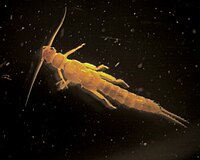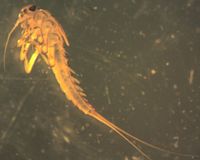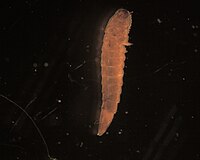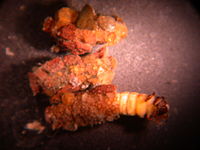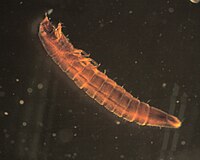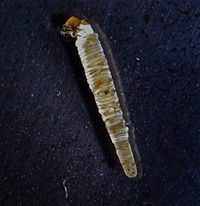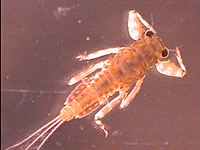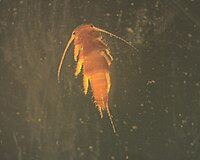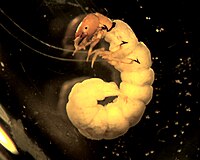Vermont EPSCoR's Streams Project; A Teacher Collaboration on WikiEducator
Openly shared content, practices, and developing resources from Vermont EPSCoR's Streams Project. Join this collaboration and make a difference!
 Deerfield River |
|---|
|
| Stream code: | DR_NBDrfld_2067 |
| Basin: | Deerfield River |
| State or Province: | Vermont |
| Country: | USA |
| Latitude: | 42.97307568 |
| Longitude: | -72.90131874 |
| School: | Twin Valley Union High School |
The following are the most common invertebrates collected from this stream site.
Chironomidae
- Order
- Diptera
- Family
- Chironomidae
- Common name
- Nonbiting midge
- Tied fly
- Griffith's Gnat
Midge larvae tend to be the most common macroinvertebrate at our sites. As with other Diptera, there are no true jointed legs. Chironomidae do have a pair of prolegs at each end and preserved individuals tend to curl into a 'C'. Identification past family requires slide-mounted heads. We have seen philopotamid caddisflies misidentified with the chironomids and we suspect that that happens when samples are being sorted from trays. Under a microscope, six prominent legs can be seen on members of the caddisfly family Philopotamidae.
More information on Philopotamidae.
Alloperla
- Order
- Plecoptera
- Family
- Chloroperlidae
- Genus
- Alloperla
Chloroperlids stoneflies are quite slender relative to most other stoneflies. The adults are green but this trait does not show up in the nymphs. Chloroperlids from this genus are characterized by a fringe of intrasegmental setae on their cerci.
Image of the intrasegmental setae.
Baetis
- Order
- Ephemeroptera
- Family
- Baetidae
- Genus
- Baetis
- Common name
- The Little Olive
- Tied fly
- Sawyer Pheasant Tail Nymph
This mayfly has three "tails" and a unique head shape. Its gills are oval shaped and insert dorsally. More mature nymphs have long, dark wing pads.
Image of the long, dark wing pads.
Optioservus
- Order
- Coleoptera
- Family
- Elmidae
- Genus
- Optioservus
The larvae of
Optioservus have open coxae, as determined by the straight definition between segments on the ventral side of the pronotum.
The adult Optioservus have a compact appearance, especially the head and thorax. There are also dorsal ridges and a characteristic diamond-shaped sutellum observable in the dorsal view.
Images of the straight definition between segments, the dorsal ridgesand the diamond-shaped scutellum.
Neophylax
- Order
- Trichoptera
- Family
- Uenoidae
- Genus
- Neophylax
- Common name
- Fool's Caddis
- Tied fly
- Peeping Caddis
Neophylax are characterized by having a sclerotized pronotum and mesonotum. They build a case of coarse sand grains often with a pair of latteral pebbles or "ballast stones". The larvae are rather stout and the head is scrunched in between the limbs. The anal hooks are attached directly to the abdomen and they rarely come out of the case when preserved. On the ventral surface of the abdominal segments, one can see darkened ovals, known as the chloride epithelia. Like the
Limnephilidae, they have a prosternal horn, though it can sometimes be small. Also, they have a dorsal hump and two lateral humps on the first abdominal segment- be careful! Often times, these features can be
squished down or damaged in the sampling process. A larva removed from it's case is shown
here.
The feature that distinguishes Uenoidae from Limnephilidae is the mesonotum: on either side of the midline, the anterior margin is notched.
Because our samples were taken in summer, we found large numbers of Neophylax pre-pupae. We anticipate that there will be fewer present in the streams in late September and many of those sampled will be at the pupal or adult stage. Samples taken in October would tend to have more empty cases.
Stenelmis
- Order
- Coleoptera
- Family
- Elmidae
- Genus
- Stenelmis
The larvae of
Stenelmis, as in
Ordobrevia, have a sternum on the ventral side of the pronotum. The main difference between the two genera is in the antennae the second segment is less than twice as long as the first in
Stenelmis.
The adult Stenelmis has a clear separation between the thorax and abdomen as well as a more distinctly separate head as compared to other genera.
Click here to see pictures of the sternum and
antennae-
Micrasema
- Order
- Trichoptera
- Family
- Brachycentridae
- Genus
- Micrasema
These larvae are typically found with their legs extended out of their case for feeding. The cases are circular in cross section and made of sand grains.
Ephemerella
- Order
- Ephemeroptera
- Family
- Ephemerellidae
- Genus
- Ephemerella
- Common name
- The Hendrickson; The Red Quill; The Hendrickson Spinner Fall
- Tied fly
- Hendrickson; Flick's Red Quill; Lunn's Particular
Mayflies in this genus have long intersegmental setae on their cerci that extend laterally and may or may not have whorls of spines at the end of each segment of their cerci. Their maxillary palps are well-developed.
Image of the intersegmental setae.
Peltoperlidae
- Order
- Plecoptera
- Family
- Peltoperlidae
- Common name
- The Little Roach-like Stonefly
- Tied fly
- Yellow Humpy
Peltoperlidae have stout, roach-like bodies and can have conical gills at the base of legs. Ventral overlapping plates are found on their large thorax. They have a single gill on each side posterior to thoracic segment 3. Peltoperlidae is not covered in the family-level key (Bouchard 2006) used by the Streams Project.
Image of the single gill on each side posterior to thoracic segment 3.
Dolophilodes
- Order
- Trichoptera
- Family
- Philopotamidae
- Genus
- Dolophilodes


